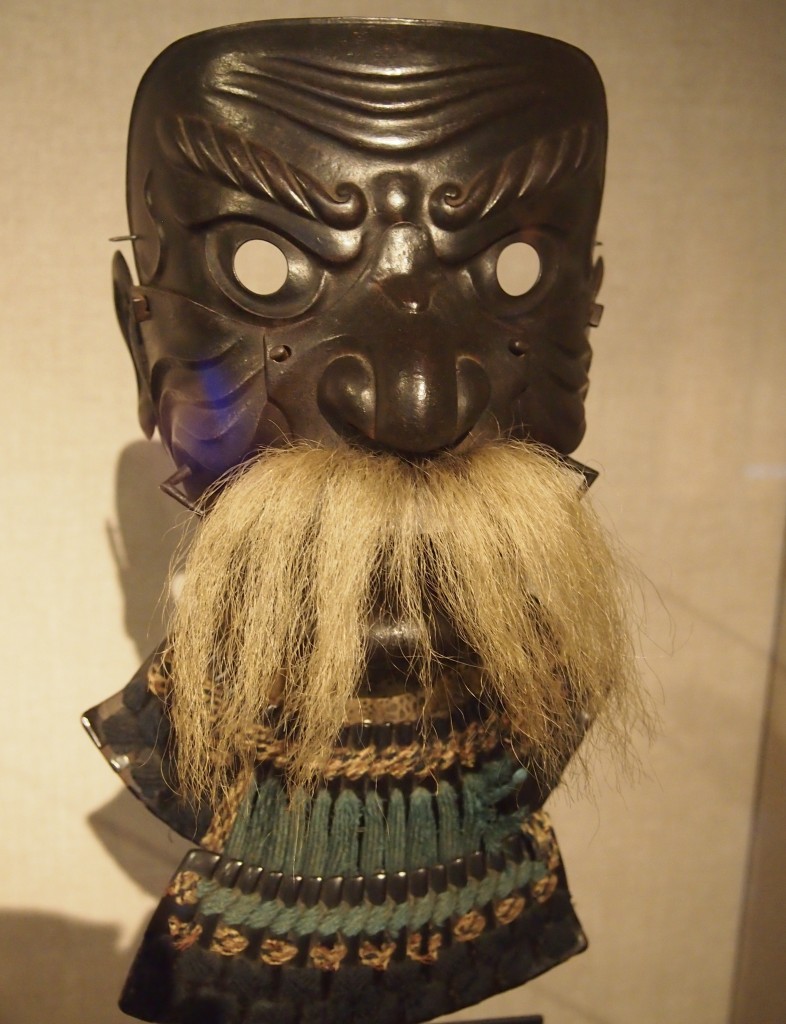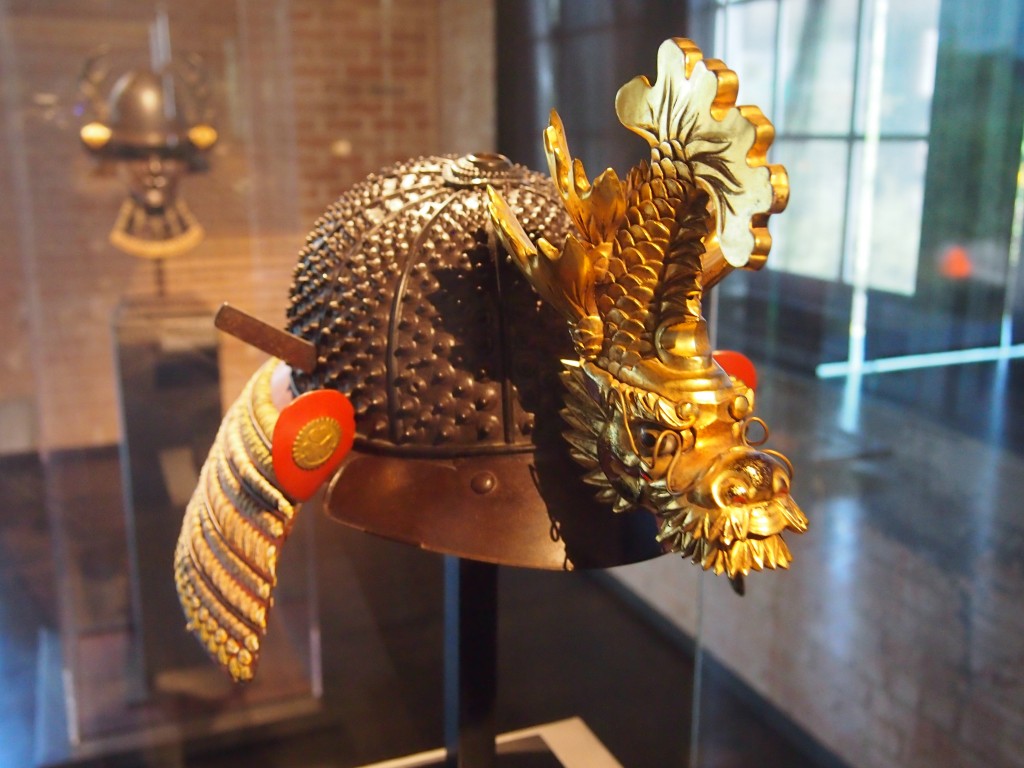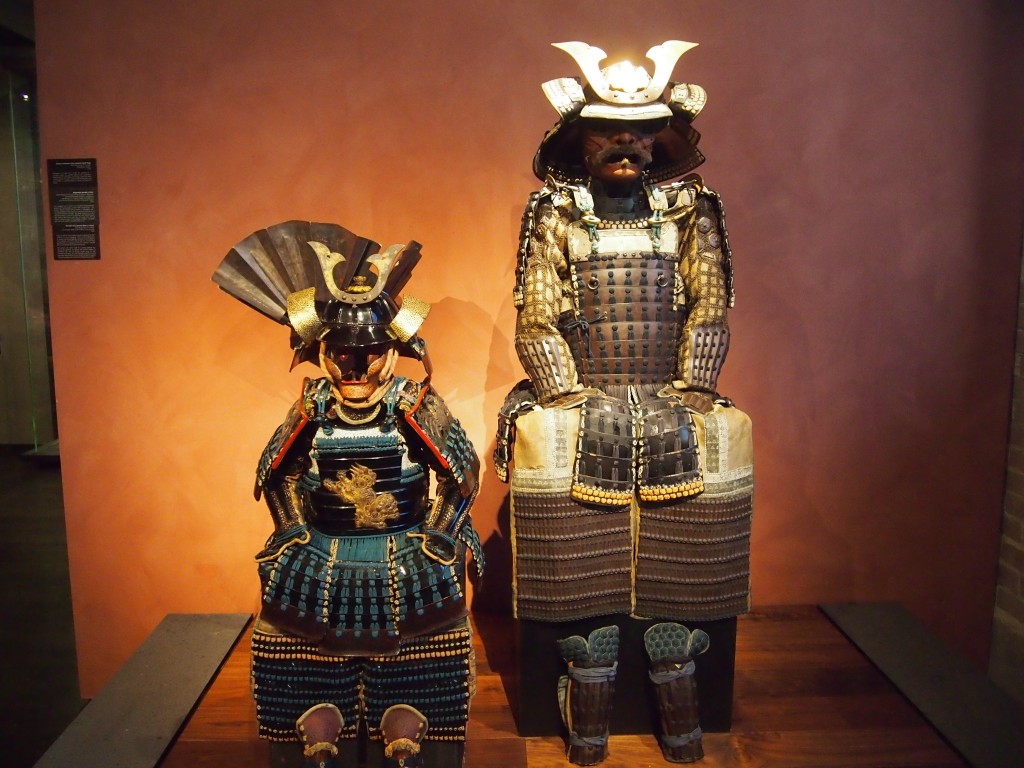The Ann & Gabriel Barbier-Mueller Museum: The Samurai Collection takes up the second floor of the St. Ann Building in Dallas’ Uptown district, which is a walkable distance from downtown, even in the late-summer heat. The museum is another new attraction for the city, open only since March.
To reach it, you enter a first-floor restaurant, pass its reception desk, and then go up some stairs. It’s a small museum with a single focus: samurai armor, weapons, masks, and related items. The museum asserts that its “collection of samurai objects is one of the largest of its type in the world and is displayed in the only museum outside Japan whose focus is samurai armor.”
Go up to the cool, quiet reaches of the museum, and pretty soon you’re face-to-face with the likes of him:
 It’s a somen (full-face mask), made of iron, leather, horsehair, lacquer and silk lacing, dating from mid-Edo – the 18th century. During earlier periods, when a samurai might actually have to do battle, somen weren’t that popular, since a mask like that can obscure your vision. In the more peaceful Edo era, that wasn’t such a concern, and the masks had a revival among samurai (at least those who could afford them).
It’s a somen (full-face mask), made of iron, leather, horsehair, lacquer and silk lacing, dating from mid-Edo – the 18th century. During earlier periods, when a samurai might actually have to do battle, somen weren’t that popular, since a mask like that can obscure your vision. In the more peaceful Edo era, that wasn’t such a concern, and the masks had a revival among samurai (at least those who could afford them).
Another cool item at the Samurai Collection is this helmet.
 It’s an akodanari kabuto, a melon-shaped helmet of iron and lacquer and dating from the Muromachi period, or the late 15th to early 16th centuries, when it was entirely likely that a samurai would be fighting someone. The museum says that “the construction of this kabuto, with twelve plates covered in protruding rivet comprising the helmet bowl, is unique. There is no other known example.”
It’s an akodanari kabuto, a melon-shaped helmet of iron and lacquer and dating from the Muromachi period, or the late 15th to early 16th centuries, when it was entirely likely that a samurai would be fighting someone. The museum says that “the construction of this kabuto, with twelve plates covered in protruding rivet comprising the helmet bowl, is unique. There is no other known example.”
These are fine artifacts, but they aren’t as grand as some full armor that the Barbier-Mueller has. In this case, one for a man, another for a boy.
 The larger suit, the museum notes, “was assembled during the Edo period and incorporates several older components. The helmet displays stylized horns known as kuwagata and a frontal ornament in the shape of a paulownia leaf, the crest of several important families…” As for the smaller suit, it’s late Edo. “Boys of samurai class families began training to become warriors at a very young age… at around age 12, samurai boys participated in a ceremony known as genpuku, wherein they received their first armor and sword.”
The larger suit, the museum notes, “was assembled during the Edo period and incorporates several older components. The helmet displays stylized horns known as kuwagata and a frontal ornament in the shape of a paulownia leaf, the crest of several important families…” As for the smaller suit, it’s late Edo. “Boys of samurai class families began training to become warriors at a very young age… at around age 12, samurai boys participated in a ceremony known as genpuku, wherein they received their first armor and sword.”
 All in all, a high-quality collection, and not such a large display that you can’t leisurely take in most of it in one visit. It’s as if a single room of some vast, first-water museum – the British Museum, the Met, the Art Institute – had detached itself and landed in Dallas. So why Dallas? The museum’s name says it all: Dallas real estate mogul Gabriel Barbier-Mueller and his wife Ann, long-time collectors of this kind of art and artifact, wanted it to be there.
All in all, a high-quality collection, and not such a large display that you can’t leisurely take in most of it in one visit. It’s as if a single room of some vast, first-water museum – the British Museum, the Met, the Art Institute – had detached itself and landed in Dallas. So why Dallas? The museum’s name says it all: Dallas real estate mogul Gabriel Barbier-Mueller and his wife Ann, long-time collectors of this kind of art and artifact, wanted it to be there.
Here’s a 2006 D article about Barbier-Mueller, scion of the Swiss family of that name who decided to live in Dallas, in as much as anyone with four houses lives in a particular place. It begins with the amusing line: “Gabriel Barbier-Mueller owns a lot of stuff.” Well, so do I. It’s just that a lot of his stuff is more expensive.